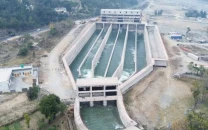The romance of history with the real Pakistan
Pakistan occupies historically one of the most significant pieces of land

In response to my column, ‘The Romance of Geography with the Real Pakistan’, published on February 11, 2021, I received a lot of feedback by Pakistani and overseas readers, surprised at the hidden secrets of our geography. This piece would deal with the historic outlook of the land that is Pakistan.
Pakistan occupies historically one of the most significant pieces of land. The Indus Valley Civilisation, along the Indus River and delta, is one of the oldest — larger than the ancient Egyptian and Mesopotamian civilisations. At its peak with some five million people, human ingenuity in the Indus Valley invented newer handicrafts and metallurgy besides building well-planned cities/towns with public baths, drainage and water supply systems.
In prehistoric times, our land had one of the largest and pervasive Buddhist kingdoms. Pushkalavati ruins near Charsadda, the stupas of Swat, Mardan, Takht-Bahi and Swabi; monasteries and universities of the Gandhara Civilisation at Sirkap near Taxila, for example… attest to this richness.
Pushkalavati (1400 BC) — at the confluence of Rivers Kabul and Swat — was the capital of the Gandhara Civilisation much later than the more famous Harappa, Moenjo Daro and other cities on the Indus. It was founded by Pushkala, the nephew of Rama, son of Bharat, and is mentioned in the Ramayana, one of the two ancient Hindu epics. Pushkalavati was the crown jewel of the sprawling Bactrian Empire in Afghanistan/Central Asia that stretched up to and beyond modern day Taxila, from 2500 BC to 1000 CE.
Swat had Buddhist universities just like the one in Neelum Valley (Azad Kashmir) and the entire area was famous worldwide for the learning of Buddhism. “Sharda Peeth” or University of Sharda (6-12th centuries CE) in Neelum Valley taught mysticism, religion, philosophy, contemporary literature, alongside astronomy and logic. It became a seat of learning for later day Hindu scholars.
How many of us know that our Buddha is actually the fasting Buddha, contrary to his South East Asian incarnation later, where Buddha is smiling and healthy? And that the Buddha statues of Bamiyan (Afghanistan) have a Pakistani connection?
Ashoka the Great’s Maurya Empire (268 to 232 BC), covered almost the entire Indian Sub-continent stretching from present-day Afghanistan to Bangladesh. Taxila was one of its two provincial capitals. It is the Buddhist Ashoka’s famous “chakra” that today adorns the Indian flag. And his edicts on stone pillars advocated notions of social and animal welfare, much before the Western world.
Makran succumbed to the armies of Caliph Umar (Allah be pleased with him) and remained part of the Umayyad/Abbasid Caliphate; ruled later by Turks and Persians. Subsequently Sindh, Makran and Balochistan became home to many wandering Arab/Turk princes around 7-8th centuries.
Kalhora Raj (1701-1783) by the erstwhile Arab nobility in Sindh — under Mughal tutelage — unified Sindh, improved literature and developed the irrigation system, making the area prosperous. Hyderabad city (1768) remains their legacy. The Kalhora were replaced by the ethnic Baloch Talpurs (1783-1843).
When Mongol armies under Genghis Khan invaded the eastern part of Khwarazm Shah’s Central Asian Empire, his energetic son Jalaluddin inflicted a crushing defeat on the Mongols in the Afghan territory (1221 AD) — very daring then. He made an audacious escape later, at present day Nizampur across the same mighty Indus, which Alexander’s armies had crossed in 326 BC.
Pakistan was home to a sustained flow of persecuted humanity from Central Asia after the Mongol invasion, and later during the expansion of the Czarist Empire when the Khanates of Central Asia fell to Russian armies in the 19-20th centuries. The British failed to conquer, the area of Balochistan in particular, by force, ultimately resorting to treaty alliances, just like they did in present day Khyber Pakhtunkhwa.
The story of the Mughal era is well-known and so are the tales of rulers and dynasties before the arrival of the Mughals under Babur in 1526. The romance of history with Pakistan is not complete without the Sikh Raj/Sikha Shahi or Sikh Khalsa Raj/Sarkar-e-Khalsa in the unified Punjab and parts of K-P (1799-1849) with Lahore as its capital.
Pakistan boasts as much as 150 of Sikhism’s holy sites including Gurdwara Janam Asthan, the Guru’s birthplace (at Nankana Sahib) near Sheikhupura; Dera Sahab and Samadhi in Lahore; and Gurdwara Punja Sahab in Hasan Abdal.
How many of us are fortunate to have visited the line of forts in the Cholistan desert, demarcating the erstwhile Bahawalpur and Rajasthan states? These 19 forts include the majestic Derawar Fort and others like Bijnot, Marot, Islamgarh, Michki, Jamgarh, Mojgarh, Khairgarh and Bhagla to name some; mostly along the banks of the erstwhile mysterious Hakra River.
Pakistan’s history owes much to the tenacity of present-day FATA districts and northern K-P, where the wily British were always confused whether to follow a “closed policy” or a “forward policy”. And Pax Britannica’s boast of the “sun never setting on the Empire” was meaningless without Pakistan’s martial belt, providing the empire with first rate soldiers from K-P and northern Punjab, continuing a legacy, as Pakhtun troops were found even in Mongol armies.
And in modern times, Pakistan and its soil staged one of the largest covert operations to sustain the Afghan jihad against the now defunct Soviet Union.
The civilised West has presumably just Romeo and Juliet. In historic romances, Pakistan has Sassi-Punnu (12th century), Heer Sial-Dheedo Ranjha (15/16th centuries), Adam Khan-Durkhanai (16th century), Mirza-Sahiban (17th century), Yusaf Khan-Sher Bano (17th century) and Sohni-Mahinwal (18th century)… to name a few.
In the Indus Valley Civilisation, geometrically-patterned buttons were used as ornaments. Cities had stepwells, litter bins and signage. Mehrgarh used bow drills in the 4th/5th millennium BC to drill holes into lapis lazuli. Scientist Al Biruni measured the Earth’s area from his observatory near today’s Pind Dadan Khan (Jhelum) in the 11th century. The story goes on and on…
So, the romance of history with this real Pakistan would continue. Our present challenges should not obscure our shiny future. Challenges prepare you for a better future and to repeat my favourite social media-ascribed lines… “tough times create strong men; strong men create easy times…”
The nay-sayers in the media and the neo-ashhrafiyya can say all they can, the real Pakistan would continue to hum past these sold-out souls. No land has so much history, so eventful a past and so much diversity and vibrancy, that is gifted to Pakistan.
In the diktat of the All Powerful, nations take turns. So, it is better to be prepared when your turn comes… and turn most certainly comes.
Published in The Express Tribune, March 4th, 2021.
Like Opinion & Editorial on Facebook, follow @ETOpEd on Twitter to receive all updates on all our daily pieces.













COMMENTS
Comments are moderated and generally will be posted if they are on-topic and not abusive.
For more information, please see our Comments FAQ